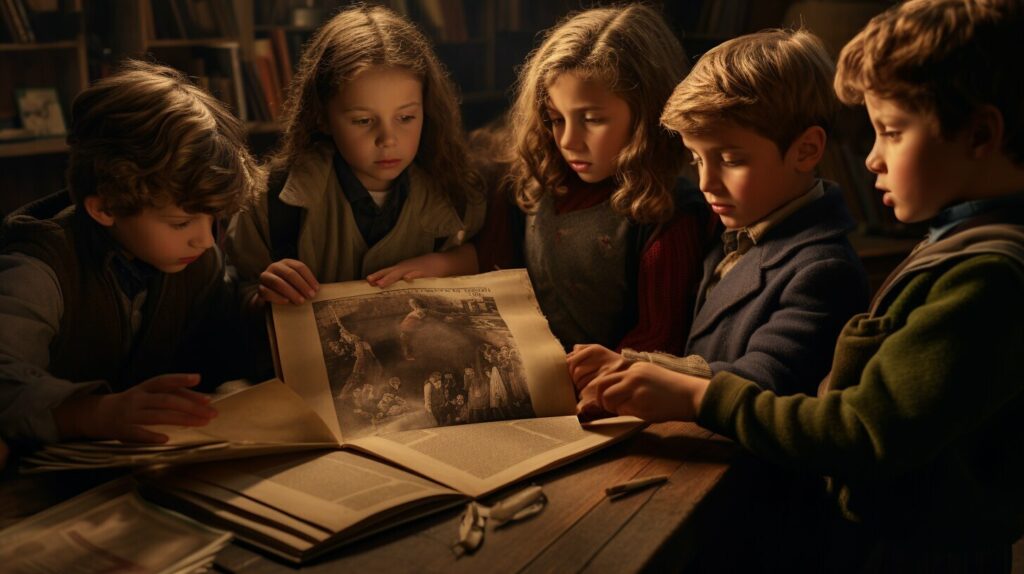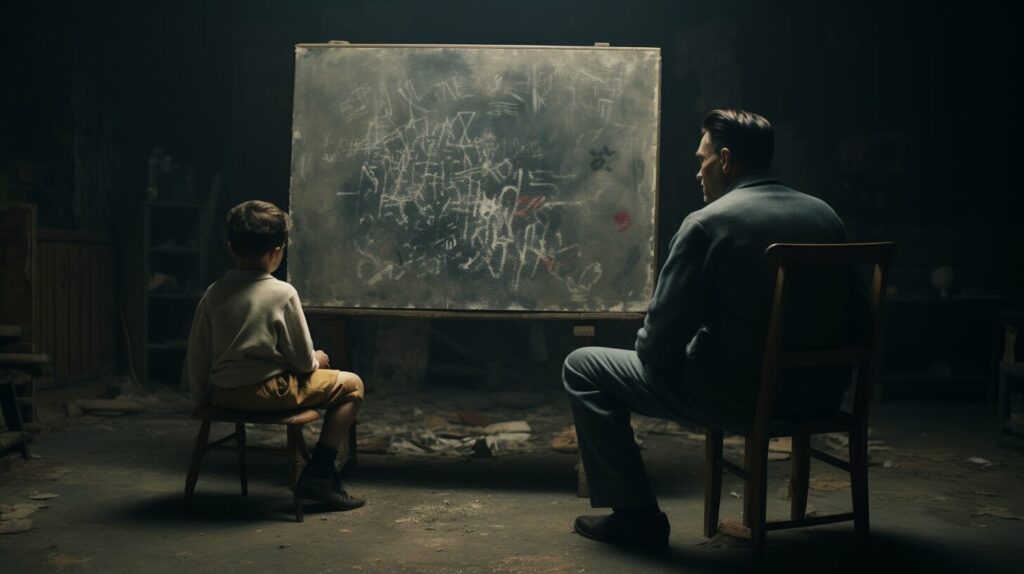Explaining complex topics like fascism to children can be difficult, but it’s important to teach them about it in a way that they can understand. Fascism is a political ideology that emerged in Europe in the early 20th century and has had a significant impact on world history.
In this article, we will provide you with a simple and friendly guide to explaining fascism to a child. We will cover everything from what fascism is to why it’s crucial for children to learn about it. By the end of this article, you’ll have a better understanding of how to approach this sensitive topic with your child.
Key Takeaways:
- Explaining fascism to children can be challenging, but it’s important to teach them about it in a way that they can understand.
- Fascism is a political ideology that emerged in Europe in the early 20th century and has had a significant impact on world history.
- By the end of this article, you’ll have a better understanding of how to approach this sensitive topic with your child.
What is Fascism?
If you are trying to explain fascism to a child, it’s important to start with a simple definition. Fascism is a type of political ideology that emphasizes the importance of the nation or state over the individual. This means that everything in a fascist society is geared towards the success of the nation, including the economy, military, and culture.
One of the key characteristics of fascism is authoritarianism, which means that a single leader or party has complete control over the government and the lives of citizens. Individual rights and freedoms are often suppressed in favor of the state, and dissent is not tolerated.
Image source: https://seowriting.ai/32_6.png
Fascism often promotes ultra-nationalism, which means that the nation is seen as superior to others. This can lead to racism and discrimination against minority groups within the country, as well as conflict with other nations.
The ideas of fascism emerged in the early 20th century, particularly in Italy and Germany, as a response to political and economic instability.
What are the key features of fascism?
| Feature | Description |
|---|---|
| Authoritarianism | A single leader or party has complete control over the government and citizens. |
| Ultra-nationalism | The nation is seen as superior to others, often leading to racism and discrimination. |
| Suppression of individual rights | Citizens may have limited freedom of speech, press, and assembly, and may be subject to surveillance and censorship. |
| Glorification of violence | Military power and aggression are celebrated, often leading to conquest and war. |
It’s important to note that fascism is a complex and often controversial topic, and different people may have different interpretations of it. However, by providing a simple definition and highlighting some of the key characteristics, you can help a child understand what fascism is and why it’s important to learn about it.
The Rise of Fascism in History
To understand fascism, it’s important to explore the historical context in which it emerged. Fascism originated in Europe in the early 20th century, in the aftermath of World War I. Many countries, including Germany and Italy, were struggling with economic turmoil and political instability.
Fascism capitalized on this instability by presenting a vision of a strong, unified nation led by a charismatic leader. The fascist ideology was built on a rejection of democracy and individual rights, instead emphasizing nationalism, militarism, and authoritarianism.
| The Rise of Fascism | Key Events |
|---|---|
| Italy | Benito Mussolini establishes fascist government in 1922 |
| Germany | Adolf Hitler becomes Chancellor in 1933, establishes Nazi dictatorship |
| Spain | Spanish Civil War (1936-1939) leads to fascist victory under General Franco |
In addition to Italy and Germany, fascist regimes emerged in several other countries, including Spain, Portugal, and Japan. These regimes were characterized by strict censorship, the suppression of free speech, and the persecution of minority groups.
The rise of fascism ultimately led to World War II, one of the deadliest conflicts in human history, and the Holocaust, in which millions of Jews and other minority groups were systematically persecuted and killed by the Nazi regime.
It’s crucial for children to learn about the historical impact of fascism and the devastating consequences of authoritarian regimes. By understanding this history, we can work towards promoting tolerance and inclusivity in our society.

Fascist Leaders
Children may be curious to learn about the people who led fascist governments and left their mark on history. Here are some of the most notorious fascist leaders:
| Leader | Country | Impact |
|---|---|---|
| Adolf Hitler | Germany | Hitler’s regime is responsible for the Holocaust, which resulted in the genocide of six million Jews, as well as the deaths of millions of others during World War II. |
| Benito Mussolini | Italy | Mussolini established a fascist government in Italy, which suppressed political opposition and aligned itself with Nazi Germany during World War II. He was executed by Italian partisans in 1945. |
| Francisco Franco | Spain | Franco led a military coup in Spain in 1936 and established a dictatorship that lasted until his death in 1975. His regime was known for its repression of opposition groups and violations of human rights. |
These leaders and their actions serve as a stark reminder of the dangers of fascism and the importance of promoting democratic values and human rights.

Fascist Ideology
It’s important to understand the core beliefs and ideals of fascism in order to recognize and counteract its harmful influence. Fascism is characterized by extreme authoritarianism, the suppression of individual rights, and the glorification of violence.
The ideology of fascism is rooted in ultra-nationalism, which promotes the idea that one’s own country is superior to others. This often goes hand in hand with racism, as fascist regimes seek to prop up a particular race as superior to all others. This leads to the dehumanization and mistreatment of minority groups, who may be subject to violence, forced labor, and other forms of oppression.
Fascism also tends to embrace militarism, viewing war and conquest as noble endeavors that are necessary for a country’s expansion and dominance. This has led to numerous conflicts throughout history, including World War II, which was largely fueled by fascist aggression.
It’s important to teach children about these harmful ideas and the impact they can have on individuals, communities, and nations. By promoting values of equality, empathy, and respect, we can help ensure that fascist ideologies never gain a foothold in our society.

Effects of Fascism
While fascism may seem appealing to some, it’s important to understand the negative consequences associated with this ideology.
Fascist regimes are known for their suppression of human rights, including freedom of speech, religion, and press. Dissent is often dealt with harshly, and those who speak out against the government may face imprisonment or worse.
Minority groups are often targeted by fascist governments, with discrimination and violence becoming commonplace. The Jewish community was one of the major targets of fascist regimes in World War II, with millions of innocent lives lost during the Holocaust.
Additionally, the impact of fascist regimes on society and the world can be devastating. The Second World War, which was in part a result of the actions taken by fascist leaders, caused widespread destruction and loss of life.
It’s important to learn about the effects of fascism to understand why this ideology is harmful and why it’s important to promote values of tolerance and respect for all individuals.

Why is it important to learn about Fascism?
Teaching children about fascism is crucial for many reasons. First and foremost, it helps to ensure that this harmful and dangerous ideology never takes root again. By understanding the history and consequences of fascism, children can develop a sense of compassion and empathy for those who have been affected by it.
Furthermore, learning about fascism promotes critical thinking skills and encourages children to question authority and power structures. It also fosters a greater appreciation for diversity and tolerance, as children learn to recognize and celebrate the differences among people.
By discussing fascism with your child, you can open up conversations about difficult topics and create a safe space for them to ask questions and express their thoughts and feelings. It’s important to approach the topic with sensitivity and age-appropriate language, but by doing so, you can help your child develop a deeper understanding of the world and their place in it.
Image description: Photo of a child holding hands with a diverse group of children. Alt attribute: promoting values of equality and respect.
Discussing Fascism with Your Child
Explaining fascism to a child can be a daunting task. However, it’s important to provide children with age-appropriate, factual information about historical events and ideologies to help them better understand the world around them. Here are some tips for discussing fascism with your child:
- Start by asking your child what they already know about fascism or if they’ve heard the term before. This will help you gauge their understanding and provide a starting point for the conversation.
- Use simple language and avoid complex terminology that may confuse or overwhelm them. Be sure to define any new words or concepts that may come up during the conversation.
- Provide context by highlighting key events or individuals associated with fascism. For example, you could discuss how fascist leaders came to power and the impact they had on their countries and the world.
- Encourage questions and actively listen to your child’s responses. This will help create an open dialogue and foster a deeper understanding of the topic.
- Reinforce values of equality and respect throughout the conversation. Explain how fascism goes against these values and highlight the importance of treating others with dignity and empathy.

Remember that discussing fascism with your child is an ongoing process. Be prepared to answer follow-up questions and continue the conversation as your child grows and their understanding of the world evolves. By providing a safe and open space for discussion, you can help your child develop critical thinking skills and promote a more tolerant and inclusive society.
Promoting Values of Equality and Respect
Teaching your child about fascism and its harm to society is an essential step toward building a brighter and more tolerant future. However, it’s equally crucial to promote positive values like equality, empathy, and respect to counter fascist ideologies.
Encourage your child to celebrate diversity and embrace differences, whether it’s in culture, race, or identity. You can also teach your child to be kind and caring towards others, regardless of their background or beliefs.
One way to promote these values is by exposing your child to diverse media and literature. For instance, books like “The Sneetches” by Dr. Seuss and “Last Stop on Market Street” by Matt de la Peña explore themes of diversity and inclusion in a relatable and fun way for children. Watching films like “Coco,” which celebrates Mexican culture, or “Hidden Figures,” which highlights the achievements of African-American women in NASA, can also help children understand the importance of diversity.
Ultimately, creating a safe and inclusive environment at home and in your community can go a long way in promoting values of equality and respect. By raising your child to be a kind and compassionate individual, you can help build a society that embraces diversity and rejects fascist ideologies.

Additional Resources for Learning
If you’re looking to continue the conversation about fascism with your child, here are some recommended resources:
Books:
- What is Fascism? And How to Fight It by Leon Trotsky
- The Rise and Fall of Adolf Hitler by William L. Shirer
- Benito Mussolini: Fascist, Italian Dictator by John R. Shook
Websites:
- History.com: Fascism
- United States Holocaust Memorial Museum: Introduction to the Holocaust
- Anti-Defamation League: Education and Resources
Documentaries:
- The Rise of Fascism: Hitler’s Germany, Mussolini’s Italy and Franco’s Spain
- Night and Fog
- Fascism in Color
These resources provide further insight and understanding into the history and impact of fascism, and can be used for further discussion and reflection with your child.

Conclusion
Congratulations, you have completed this simple and friendly guide on how to explain fascism to a child! By now, you should have a good understanding of what fascism is, how it developed, and the negative consequences associated with it. You also have some useful tips on how to discuss this complex topic with your child in an age-appropriate and engaging way.
Remember, learning about fascism is not only crucial for understanding history, but it also promotes values of inclusivity, diversity, and respect. By teaching your child about fascism and its harmful effects, you are helping them develop critical thinking skills, empathy, and tolerance.
Keep in mind that discussing fascism with your child is just one step towards cultivating a more tolerant and inclusive society. It’s important to continue promoting positive values and behaviors through your own actions, and to seek out additional resources and support as needed.
Thank you for reading!
Is it Appropriate to Explain Globalization to a Child in a Similar Way as Fascism?
When discussing complex concepts like globalization with a child, it is important to choose an appropriate approach. Drawing comparisons between globalization and fascism may not be suitable. Instead, focus on simplifying the idea by emphasizing how people from different countries connect and share ideas, goods, and cultures. Make it relatable and encourage curiosity by using examples such as travel, communication, and international foods. These tips for explaining globalization to a child can help foster their understanding and appreciation for our interconnected world.
FAQ
Q: How do I explain fascism to a child?
A: Explaining fascism to a child can be done in a simple and friendly manner. Start by describing fascism as a type of government where one leader has total control and makes all the decisions. You can explain that it is a system where individual rights are often taken away, and people are expected to obey the leader without question. It’s important to emphasize that fascism is not a positive or fair way of governing, and that it goes against the values of equality and respect.
Q: What is fascism?
A: Fascism is a type of government where one leader has complete power and controls all aspects of society. It is characterized by authoritarianism and the suppression of individual rights. In a fascist regime, people are expected to blindly follow the leader’s orders and dissent or criticism is not tolerated. It is important to teach children that fascism is not a fair or just system and that it goes against the values of equality and freedom.
Q: How can I teach my child about the rise of fascism in history?
A: Teaching children about the historical context in which fascism emerged can be done by introducing key events and countries where fascist regimes were established. You can explain that fascism gained momentum during a time of economic instability and political upheaval, and that it led to devastating consequences during World War II. It is important to emphasize the importance of understanding history as a way to learn from past mistakes and promote inclusivity and tolerance.
Q: Who were some leaders of fascist governments?
A: Some well-known leaders of fascist governments include Adolf Hitler in Germany and Benito Mussolini in Italy. These leaders had a significant impact on history and were responsible for implementing fascist ideologies in their respective countries. It’s important to teach children that these leaders promoted harmful beliefs and that their actions had devastating consequences.
Q: What are the core beliefs of fascism?
A: Fascism is characterized by beliefs such as ultra-nationalism, racism, and the glorification of violence. Fascists often promote the idea that one race or nation is superior to others, and they support the use of force and aggression to achieve their goals. It’s important to teach children that these beliefs are harmful and go against the values of equality and respect.
Q: What are the negative effects of fascism?
A: The negative consequences of fascism include the suppression of human rights, the targeting and persecution of minority groups, and the devastation caused by fascist regimes during World War II. It’s important to teach children about these effects to promote awareness and empathy towards those who have suffered under fascist rule and to emphasize the importance of protecting human rights.
Q: Why is it important to learn about fascism?
A: Learning about fascism is crucial because it helps us understand the past and learn from history’s mistakes. By teaching children about fascism, we can promote tolerance, inclusivity, and empathy. It’s important for children to know that everyone deserves equal rights and that discrimination and prejudice are harmful and go against the core values of a fair and just society.
Q: How can I discuss fascism with my child?
A: When discussing fascism with your child, it’s important to use age-appropriate language and tailor your approach to their understanding. Start with simple concepts and gradually build upon them as they grasp the topic. You can engage them in discussions, ask open-ended questions, and encourage critical thinking. It’s also helpful to include age-appropriate activities or books that can further enhance their understanding.
Q: How can we promote values of equality and respect to counter fascism?
A: Promoting values of equality, empathy, and respect is an effective way to counter the harmful ideologies associated with fascism. Encourage open-mindedness, teach about different cultures and backgrounds, and emphasize the importance of treating everyone with kindness and fairness. By fostering an environment that celebrates diversity and inclusivity, we can help prevent the spread of harmful ideologies.
Q: What additional resources are available for learning about fascism?
A: There are many books, websites, and other resources available that can assist children in learning about fascism. Some recommended resources include books like “The Boy Who Dared” by Susan Campbell Bartoletti and “The Hiding Place” by Corrie ten Boom. Websites like History.com and the United States Holocaust Memorial Museum also provide educational content about fascism. Additionally, museums and educational organizations often offer exhibits and programs focused on teaching about fascism in an engaging and age-appropriate manner.






